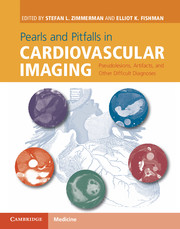 Pearls and Pitfalls in Cardiovascular Imaging
Pearls and Pitfalls in Cardiovascular Imaging from Section 4 - Coronary arteries
Published online by Cambridge University Press: 05 June 2015
Imaging description
In myocardial bridging, the epicardial coronary arteries, normally surrounded by fat, dive inferiorly and course through myocardial tissue before exiting distally back into the epicardial fat. Myocardial bridging can range in length from a few millimeters to several centimeters and be of variable depth, typically between 1–4 mm. Bridged segments are recognized on coronary CT when the coronary arteries are circumferentially surrounded by myocardial tissue (Figure 35.1). The left anterior descending coronary artery is the most commonly involved; however, the circumflex and right coronary arteries may also have bridged segments (Figure 35.2). If multiphase images are acquired, narrowing of the intramyocardial segment may be seen during systole as the myocardium contracts. On catheter angiography, this is referred to as the “milking effect” and is the classic finding for the diagnosis of myocardial bridging. In patients with coronary artery disease, atherosclerosis will spare the bridged segment, with plaques typically developing proximal to the segment of bridging (Figure 35.3).
Importance
In the vast majority of cases, myocardial bridging is a benign finding incidentally encountered at cardiac imaging of no clinical consequence. Some studies have associated long and deep myocardial bridges with the presence of ischemia. Intramyocardial segments have been rarely associated with cardiac events such as myocardial infarction or sudden death in small series and case reports. Based upon long-term follow-up studies of patients diagnosed by catheter angiography, the prognosis for patients with myocardial bridging diagnosed with bridging by catheter is very good. Although large cohort studies are lacking, in two studies of patients with bridging identified by coronary CT, 31/74 and 117/334 had bridged segments; however, there was no association between presence of bridging and adverse cardiac events after several years of follow-up.
Typical clinical scenario
Myocardial bridging is frequently encountered at coronary CT.
To save this book to your Kindle, first ensure [email protected] is added to your Approved Personal Document E-mail List under your Personal Document Settings on the Manage Your Content and Devices page of your Amazon account. Then enter the ‘name’ part of your Kindle email address below. Find out more about saving to your Kindle.
Note you can select to save to either the @free.kindle.com or @kindle.com variations. ‘@free.kindle.com’ emails are free but can only be saved to your device when it is connected to wi-fi. ‘@kindle.com’ emails can be delivered even when you are not connected to wi-fi, but note that service fees apply.
Find out more about the Kindle Personal Document Service.
To save content items to your account, please confirm that you agree to abide by our usage policies. If this is the first time you use this feature, you will be asked to authorise Cambridge Core to connect with your account. Find out more about saving content to Dropbox.
To save content items to your account, please confirm that you agree to abide by our usage policies. If this is the first time you use this feature, you will be asked to authorise Cambridge Core to connect with your account. Find out more about saving content to Google Drive.